Bearing-Weak-Fault Signal Enhancement and Diagnosis Based on Multivariate Statistical Hilbert Differential TEO
Abstract
1. Introduction
- (1)
- A multivariate-matrix distance metric method incorporating multidimensional fault features is proposed, which can effectively characterize subtle spectral differences between faulty and healthy signals. By employing statistical criteria, it precisely localizes target fault-sensitive frequency bands, demonstrating superior characterization capability compared to single frequency-domain statistical indicators.
- (2)
- The application of HDTEO as a post-processing step for MSF effectively extracts transient energy variations in the signal, addressing the persistent issue of residual in-band noise inherent in multi-band filtering systems. This approach significantly suppresses residual noise, thereby achieving optimal extraction of weak-fault signal characteristics.
- (3)
- Validation on both public bearing datasets and experimental bench tests demonstrates that the proposed method effectively enhances weak-fault features in vibration signals, even under strong background noise conditions during early-stage bearing faults. The enhanced signals enable straightforward fault diagnosis through envelope spectrum analysis.
2. Overview of Bearing-Fault Diagnosis
2.1. Enhancement and Diagnosis of Weak Bearing-Fault Signals
- (1)
- For the bearing-vibration fault signals (the signals to be diagnosed) and reference signals (healthy signals) collected from rotating machinery, the initial step involves segmental processing in the time–frequency domain, followed by the extraction of multi-order frequency-domain statistical indicators from each frequency band.
- (2)
- A multivariate matrix integrating multidimensional fault features of both fault and reference signals across all sub-bands is sequentially constructed. KPCA is subsequently applied to extract the first principal eigenvalue, followed by the calculation of a distance metric based on the extracted eigenvalues.
- (3)
- Based on the significant divergence observed in the distance metric, a multivariate statistical filtering threshold criterion is designed to identify the target fault-sensitive frequency bands.
- (4)
- The inverse Fourier transform (IFFT) is applied to the selected target frequency bands to obtain the filtered fault signal. Subsequently, HDTEO processing is performed to effectively suppress residual in-band noise.
- (5)
- Fault characteristic frequency is directly extracted through envelope spectrum analysis to ultimately accomplish fault diagnosis.
2.2. Bearing-Fault Characteristic Frequency
3. Methodology
3.1. Multivariate Statistical Filtering
3.1.1. Construction of Multivariate Matrices
| Frequency-Domain Statistic | Equations | Multidimensional Features of Faults | |
|---|---|---|---|
| Frequency centroid (FC): | (7) | Reflects the frequency position of fault energy concentration. | |
| Root mean square (RMS): | (8) | Quantifies the energy intensity of fault signals. | |
| Standard deviation (STD): | (9) | Measures the dispersion degree of fault frequencies. | |
| Variance (VAR): | (10) | Quantifies the overall scale of frequency fluctuations. | |
| Skewness (SKE): | (11) | Characterizes the symmetry features of the fault spectrum. | |
| Kurtosis (KUR): | (12) | Captures the features of fault impact components. | |
3.1.2. Filtering Criteria
3.2. Hilbert Differential Teager Energy Operator
4. Experimental Study
4.1. A Study of the Public Dataset of Rolling Bearings
4.1.1. Signal Description
4.1.2. Multi-Order Statistics in the Frequency Domain
4.1.3. Study Results
4.2. Validation of Bearing Test Platform Datasets
4.2.1. Test Platform and Signal Description
4.2.2. Bearing Outer-Race Fault Diagnosis
4.2.3. Bearing Roller and Inner-Race Fault Diagnosis
5. Comparative Experiments
6. Conclusions
Author Contributions
Funding
Data Availability Statement
Conflicts of Interest
References
- Ma, S.; Han, Q.; Chu, F. Sparse representation learning for fault feature extraction and diagnosis of rotating machinery. Expert Syst. Appl. 2023, 232, 120858. [Google Scholar] [CrossRef]
- Kannan, V.; Zhang, T.; Li, H. A review of the intelligent condition monitoring of rolling element bearings. Machines 2024, 12, 484. [Google Scholar] [CrossRef]
- Peng, C.; Wei, J.; Liu, K.; Cao, H. Dynamic characteristics of angular contact ball bearings with mild defect on outer raceway. Eng. Fail. Anal. 2025, 178, 109721. [Google Scholar] [CrossRef]
- Rui, L.; Ding, X.; Wu, S.; Wu, Q.; Shao, Y. Signal processing collaborated with deep learning: An interpretable FIRNet for industrial intelligent diagnosis. Mech. Syst. Signal Process. 2024, 212, 111314. [Google Scholar] [CrossRef]
- Zaman, W.; Siddique, M.F.; Khan, S.U.; Kim, J.M. A new dual-input CNN for multimodal fault classification using acoustic emission and vibration signals. Eng. Fail. Anal. 2025, 179, 109787. [Google Scholar] [CrossRef]
- Hou, B.; Feng, X.; Kong, J.Z.; Tsui, K.L.; Wang, D. Optimized weights spectrum autocorrelation: A new and promising method for fault characteristic frequency identification for rotating machine fault diagnosis. Mech. Syst. Signal Process. 2023, 191, 110200. [Google Scholar] [CrossRef]
- Touati, K.O.M.; Boudiaf, M.; Mazouz, L.; Cherroun, L. Efficient hybrid strategy based on FFT and fuzzy logic techniques applied to fault diagnosis in power transmission line. Soft Comput. 2024, 28, 8911–8930. [Google Scholar] [CrossRef]
- Liu, R.; Ding, X.; Liu, S.; Zheng, H.; Xu, Y.; Shao, Y. Knowledge-informed FIR-based cross-category filtering framework for interpretable machinery fault diagnosis under small samples. Reliab. Eng. Syst. Saf. 2025, 254, 110610. [Google Scholar] [CrossRef]
- Lin, H.; Wu, F.; He, G. Rolling bearing fault diagnosis using impulse feature enhancement and nonconvex regularization. Mech. Syst. Signal Process. 2020, 142, 106790. [Google Scholar] [CrossRef]
- Chen, Z.; Guo, L.; Gao, H.; Yu, Y.; Wu, W.; You, Z.; Dong, X. A fault pulse extraction and feature enhancement method for bearing fault diagnosis. Measurement 2021, 182, 109718. [Google Scholar] [CrossRef]
- Gao, K.; Xu, X.; Li, J.; Jiao, S.; Shi, N. Research on feature enhancement method of weak fault signal of rotating machinery based on adaptive stochastic resonance. J. Mech. Sci. Technol. 2022, 36, 553–563. [Google Scholar] [CrossRef]
- Shi, P.; Li, M.; Zhang, W.; Han, D. Weak signal enhancement for machinery fault diagnosis based on a novel adaptive multi-parameter unsaturated stochastic resonance. Appl. Acoust. 2022, 189, 108609. [Google Scholar] [CrossRef]
- Liu, Z.; Jin, Y.; Zuo, M.J.; Peng, D. ACCUGRAM: A novel approach based on classification to frequency band selection for rotating machinery fault diagnosis. ISA Trans. 2019, 95, 346–357. [Google Scholar] [CrossRef] [PubMed]
- Guo, J.; Liu, Y.; Yang, R.; Sun, W.; Xiang, J. Differgram: A convex optimization-based method for extracting optimal frequency band for fault diagnosis of rotating machinery. Expert Syst. Appl. 2024, 245, 123051. [Google Scholar] [CrossRef]
- Song, L.Y.; Wang, H.Q.; Gao, J.J.; Yang, J.F.; Liu, W.B.; Chen, P. Application of statistics filter method and clustering analysis in fault diagnosis of roller bearings. J. Phys. Conf. Ser. 2012, 364, 012024. [Google Scholar] [CrossRef]
- Zeng, M.; Yang, Y.; Zheng, J.; Cheng, J. Maximum margin classification based on flexible convex hulls for fault diagnosis of roller bearings. Mech. Syst. Signal Process. 2016, 66, 533–545. [Google Scholar] [CrossRef]
- Rostaghi, M.; Khatibi, M.M.; Ashory, M.R.; Azami, H. Bearing fault diagnosis using refined composite generalized multiscale dispersion entropy-based skewness and variance and multiclass FCM-ANFIS. Entropy 2021, 23, 1510. [Google Scholar] [CrossRef]
- Liu, D.; Cui, L.; Wang, H. Rotating machinery fault diagnosis under time-varying speeds: A review. IEEE Sens. J. 2023, 23, 29969–29990. [Google Scholar] [CrossRef]
- Tang, H.; Liao, Z.; Ozaki, Y.; Chen, P. Stepwise intelligent diagnosis method for rotor system with sliding bearing based on statistical filter and stacked auto-encoder. Appl. Sci. 2020, 10, 2477. [Google Scholar] [CrossRef]
- Fang, L.; Liu, S.; Cheng, F. Early micro-short circuit fault diagnosis of lithium battery pack based on Pearson correlation coefficient and KPCA. Comput. Electr. Eng. 2024, 118, 109481. [Google Scholar] [CrossRef]
- Chen, B.; Cheng, Y.; Zhang, W.; Gu, F.; Mei, G. Optimal frequency band selection using blind and targeted features for spectral coherence-based bearing diagnostics: A comparative study. ISA Trans. 2022, 127, 395–414. [Google Scholar] [CrossRef]
- Xu, H.; Zhou, S. Maximum L-Kurtosis deconvolution and frequency-domain filtering algorithm for bearing fault diagnosis. Mech. Syst. Signal Process. 2025, 223, 111916. [Google Scholar] [CrossRef]
- Xu, B.; Zhou, F.; Li, H.; Yan, B.; Liu, Y. Early fault feature extraction of bearings based on Teager energy operator and optimal VMD. ISA Trans. 2019, 86, 249–265. [Google Scholar] [CrossRef]
- Gu, R.; Chen, J.; Hong, R.; Wang, H.; Wu, W. Incipient fault diagnosis of rolling bearings based on adaptive variational mode decomposition and Teager energy operator. Measurement 2020, 149, 106941. [Google Scholar] [CrossRef]
- Wang, B.; Lei, Y.; Li, N.; Li, N. A hybrid prognostics approach for estimating remaining useful life of rolling element bearings. IEEE Trans. Reliab. 2018, 69, 401–412. [Google Scholar] [CrossRef]
- Liao, Z.; Song, X.; Jia, B.; Chen, P. Bearing fault feature enhancement and diagnosis based on statistical filtering and 1.5-dimensional symmetric difference analytic energy spectrum. IEEE Sens. J. 2021, 21, 9959–9968. [Google Scholar] [CrossRef]
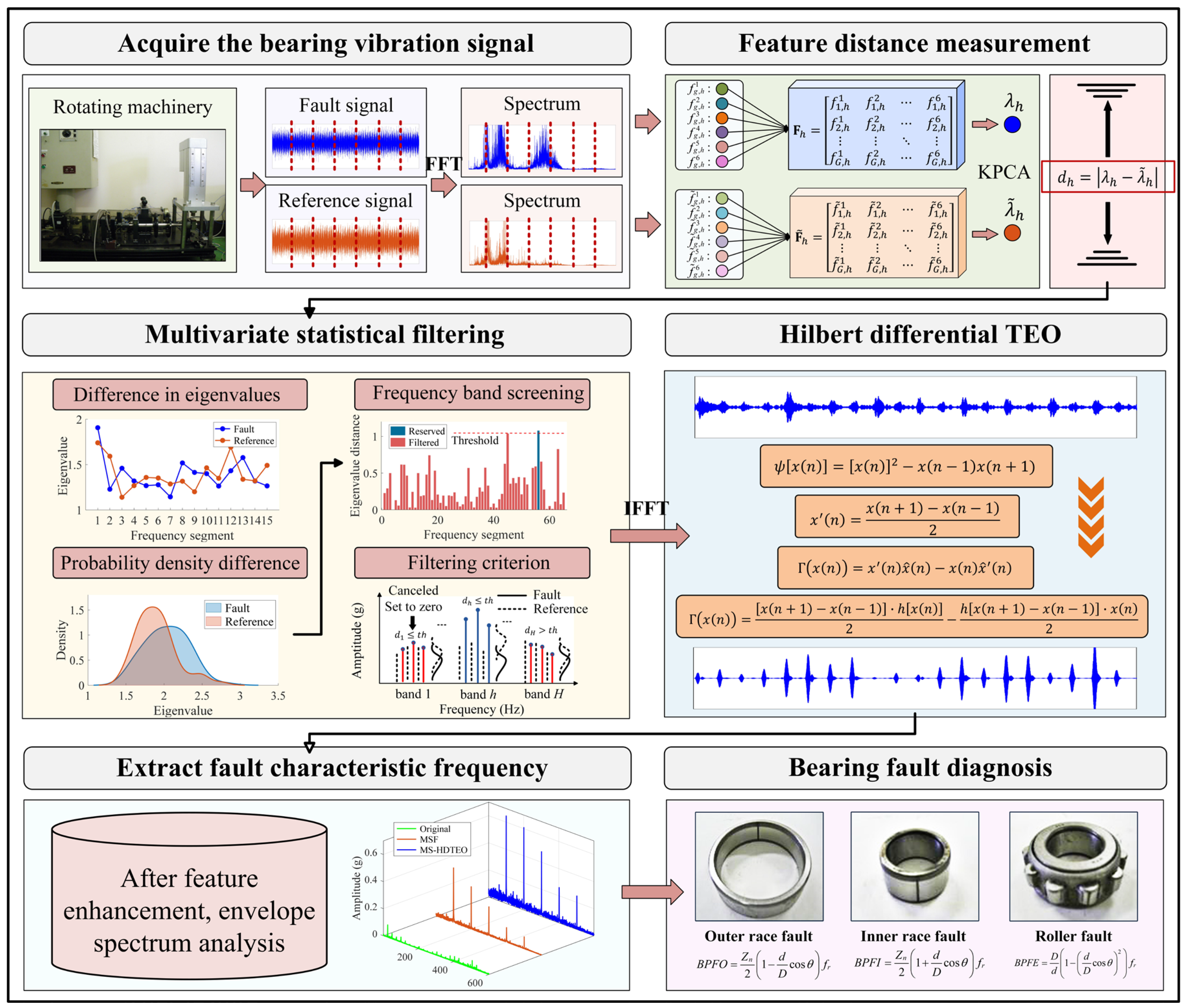

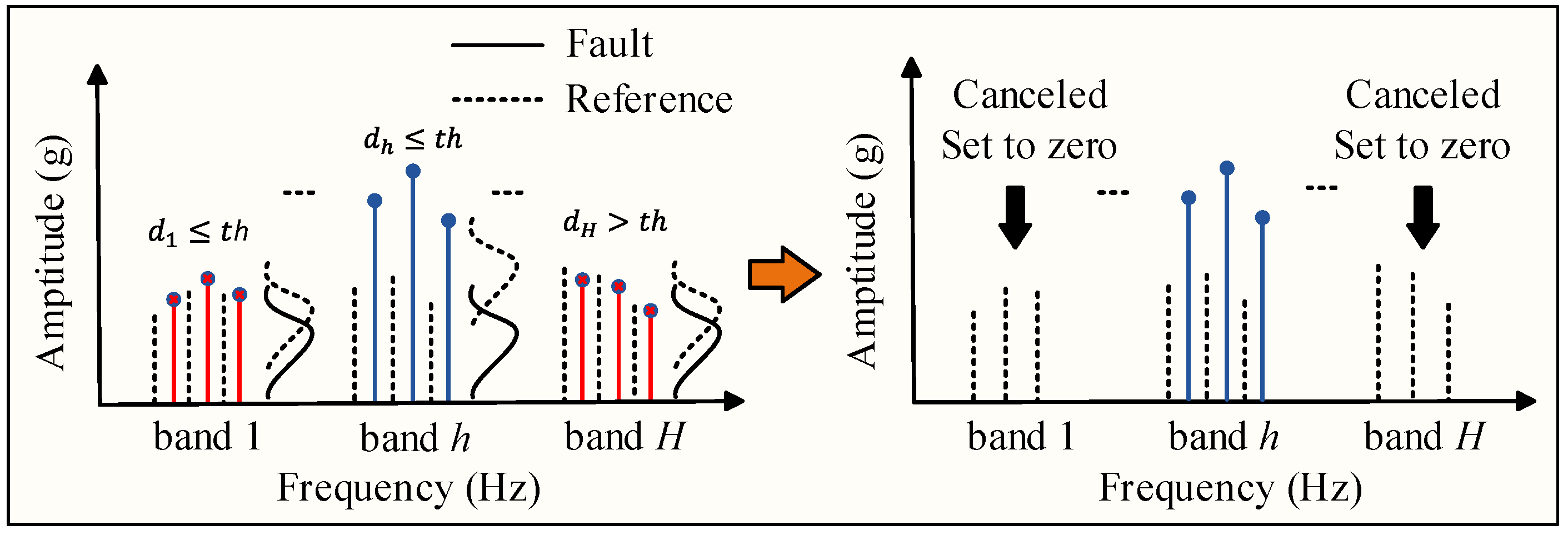





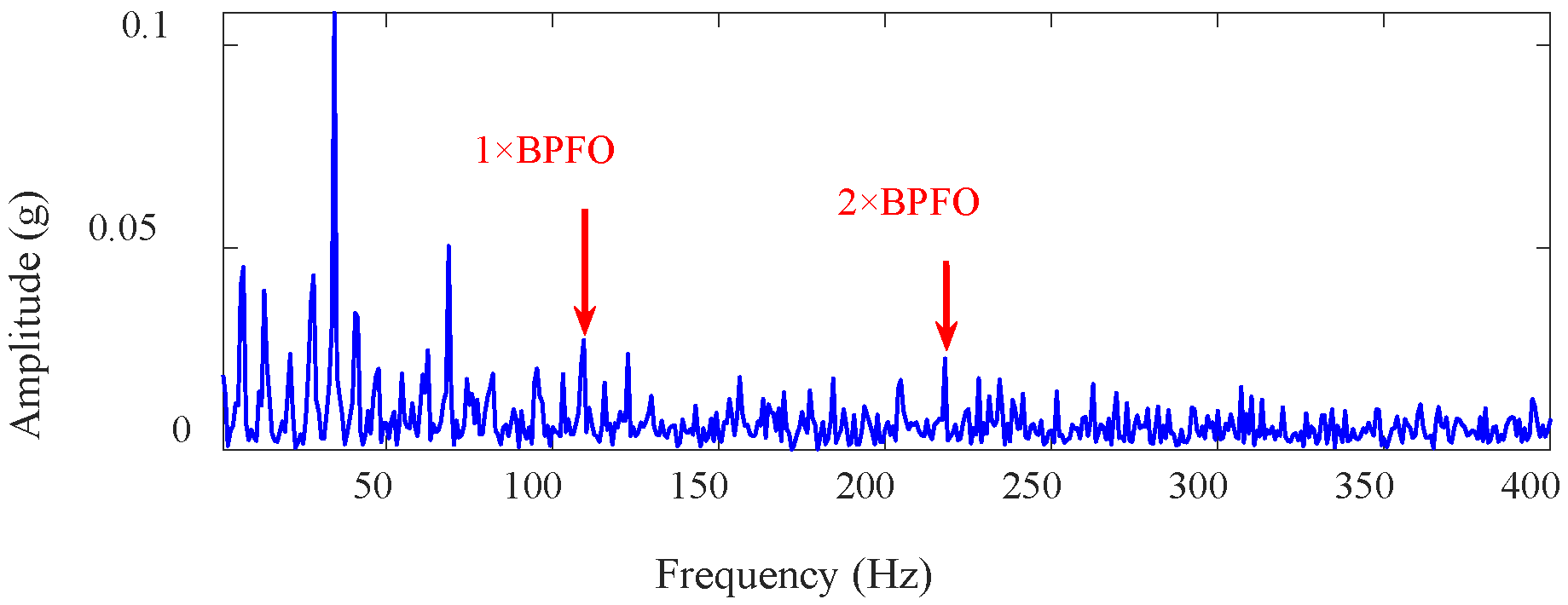


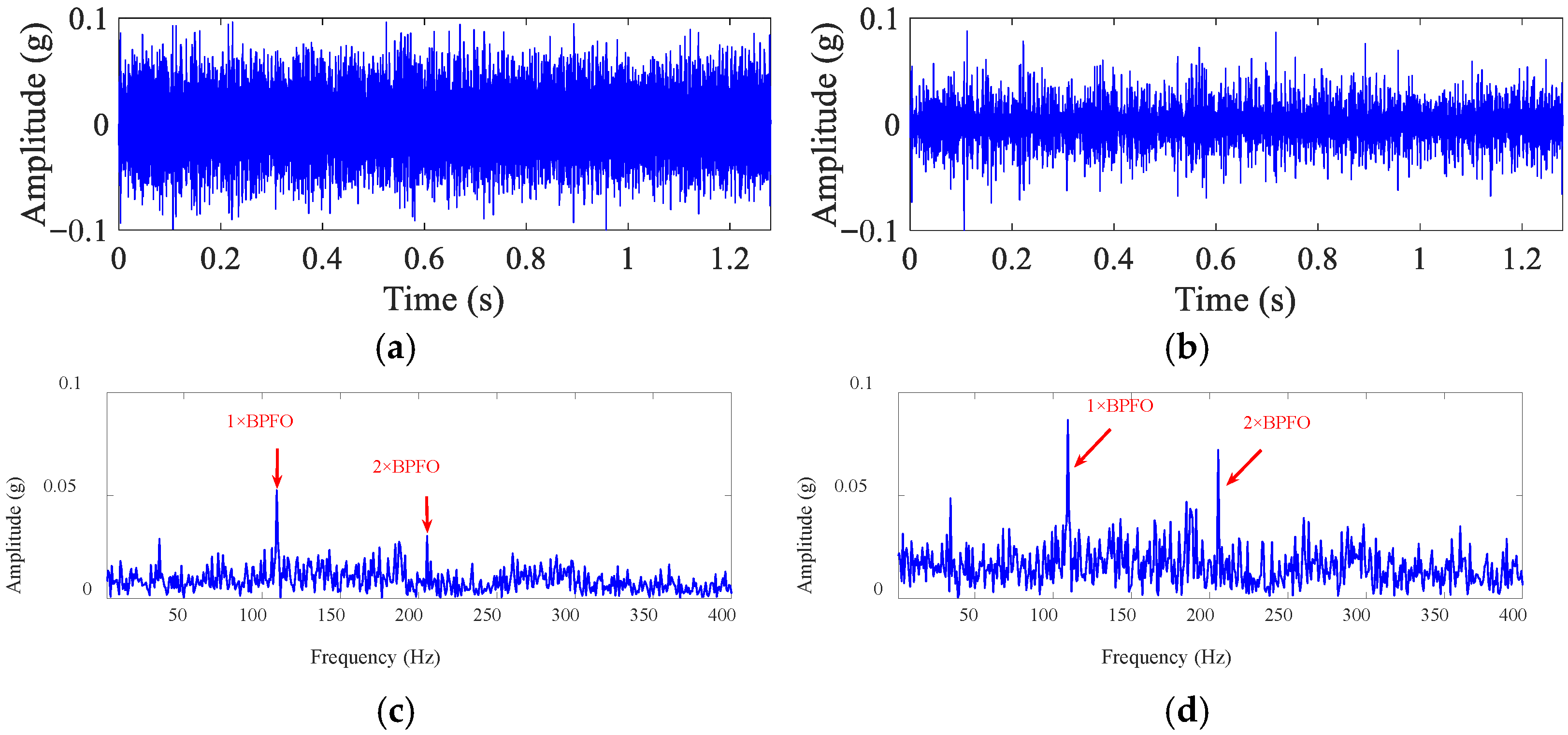
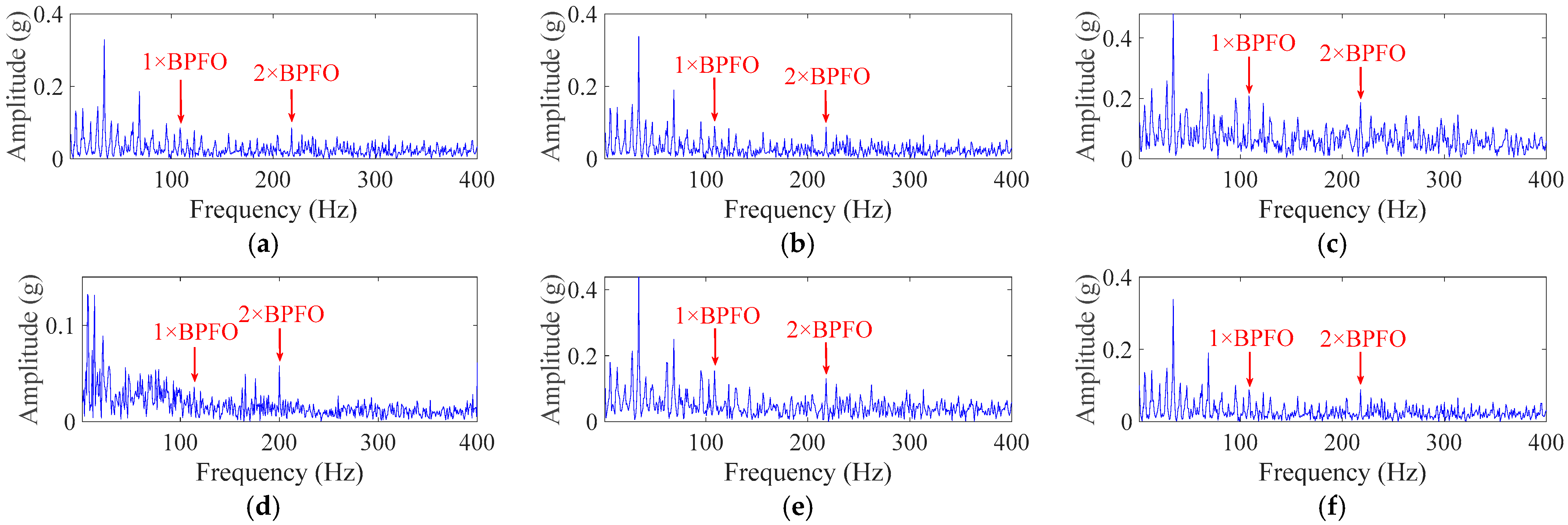
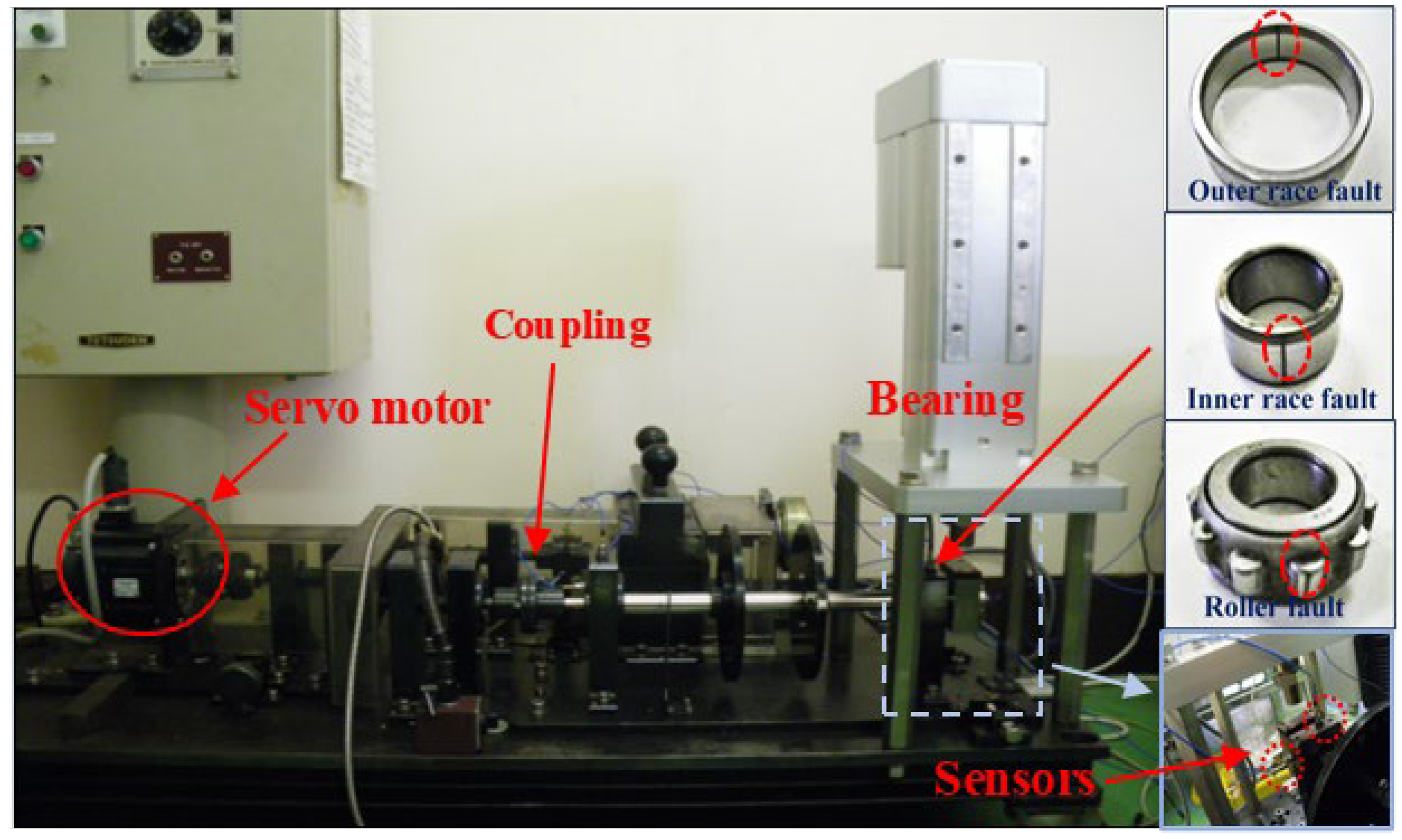


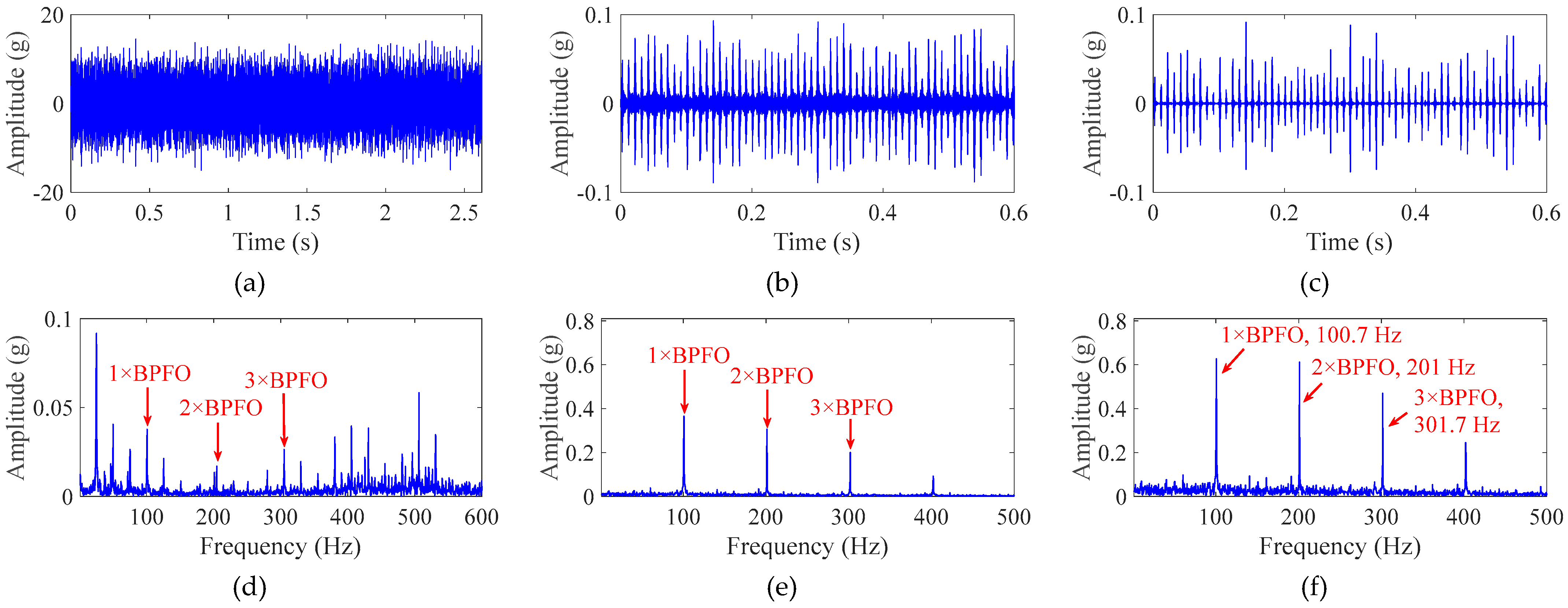


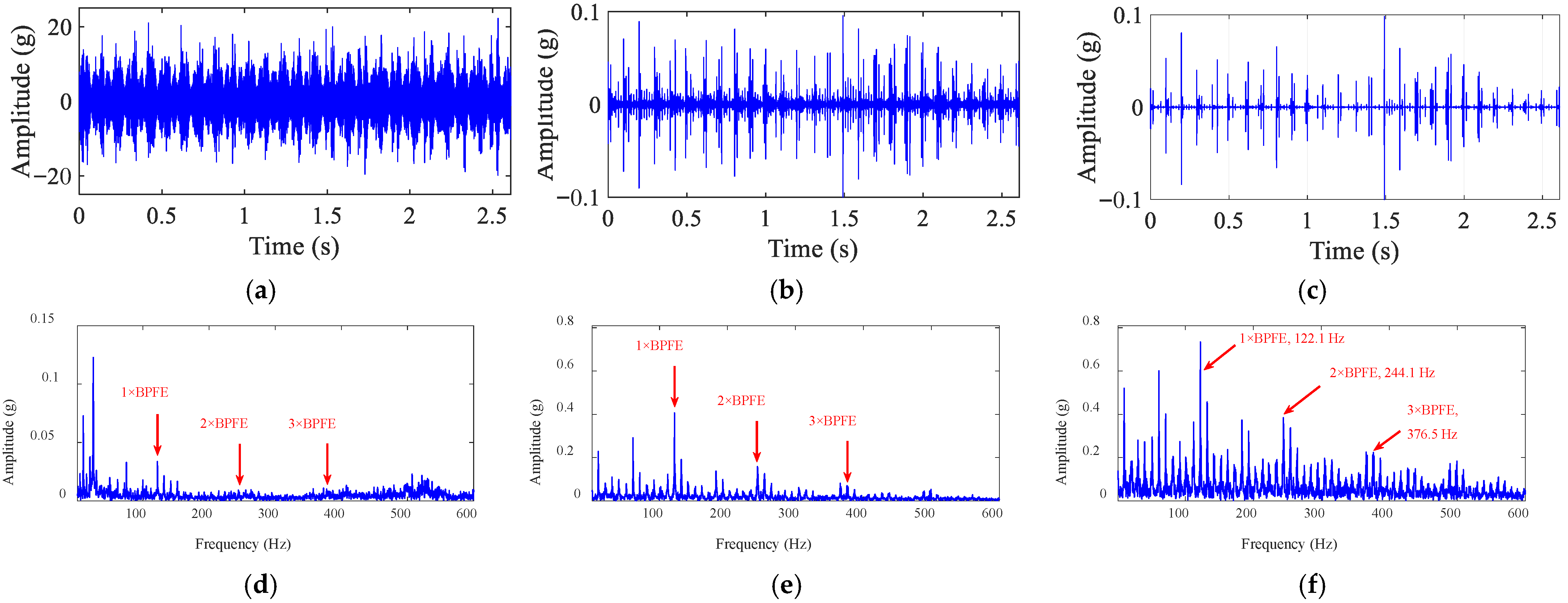
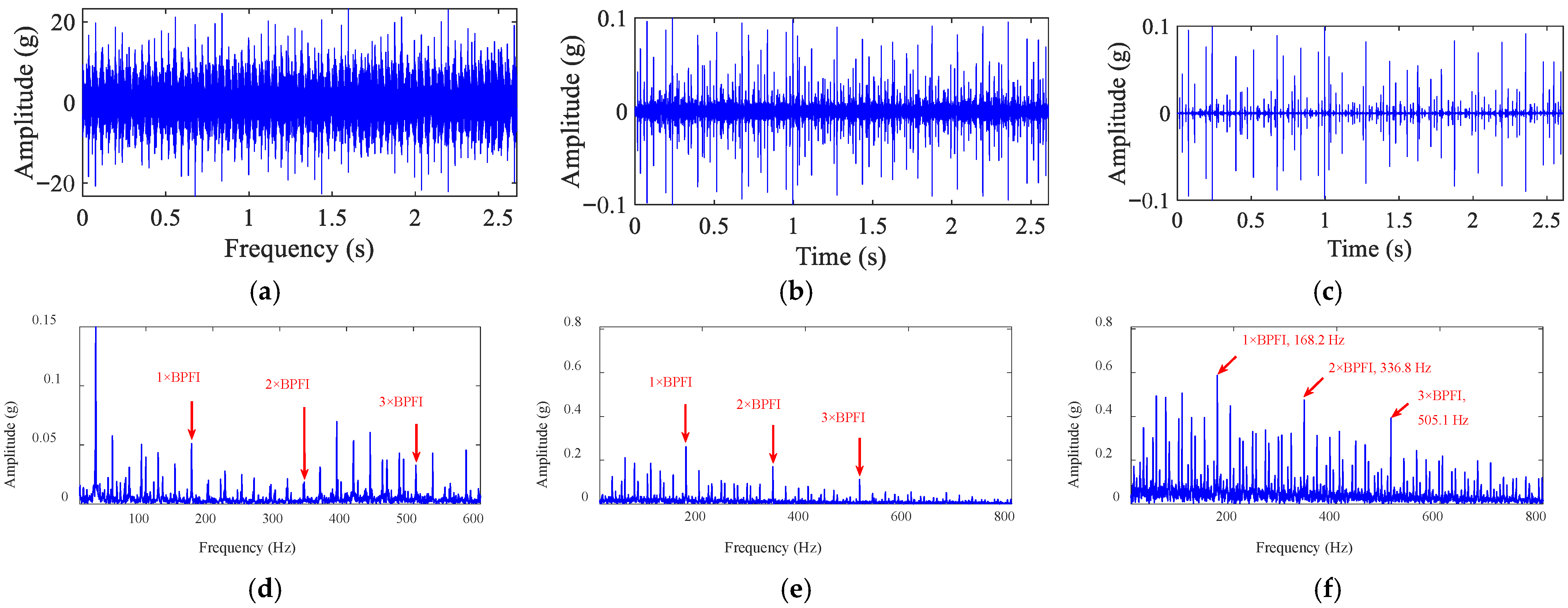
| Parameter | Value | |
|---|---|---|
| Bearing parameters | ) | 8 |
| ) | 7.92 mm | |
| ) | 34.55 mm | |
| ) | 0 | |
| ) | 35 Hz |
| Parameter | Value | |
|---|---|---|
| Bearing parameters | ) | 10 (or 11) |
| ) | 6.5 mm | |
| ) | 32.25 mm | |
| ) | 0 | |
| ) | 25 Hz |
| Methods | SII | SVI | Time (s) |
|---|---|---|---|
| The proposed method | 0.96 | 1.43 | 1.49 |
| MSF | 0.92 | 1.11 | 1.46 |
| HPF | 0.92 | 1.07 | 1.07 |
| EMD | 0.94 | 1.05 | 1.43 |
| VMD | 0.92 | 1.36 | 45.57 |
| SVD | 0.38 | 0.38 | 14.66 |
| FK | 0.85 | 0.81 | 2.97 |
| SHF | 0.92 | 1.09 | 1.34 |
Disclaimer/Publisher’s Note: The statements, opinions and data contained in all publications are solely those of the individual author(s) and contributor(s) and not of MDPI and/or the editor(s). MDPI and/or the editor(s) disclaim responsibility for any injury to people or property resulting from any ideas, methods, instructions or products referred to in the content. |
© 2025 by the authors. Licensee MDPI, Basel, Switzerland. This article is an open access article distributed under the terms and conditions of the Creative Commons Attribution (CC BY) license (https://creativecommons.org/licenses/by/4.0/).
Share and Cite
Liao, Z.; Cai, R.; Yan, Z.; Chen, P.; Song, X. Bearing-Weak-Fault Signal Enhancement and Diagnosis Based on Multivariate Statistical Hilbert Differential TEO. Machines 2025, 13, 722. https://doi.org/10.3390/machines13080722
Liao Z, Cai R, Yan Z, Chen P, Song X. Bearing-Weak-Fault Signal Enhancement and Diagnosis Based on Multivariate Statistical Hilbert Differential TEO. Machines. 2025; 13(8):722. https://doi.org/10.3390/machines13080722
Chicago/Turabian StyleLiao, Zhiqiang, Renchao Cai, Zhijia Yan, Peng Chen, and Xuewei Song. 2025. "Bearing-Weak-Fault Signal Enhancement and Diagnosis Based on Multivariate Statistical Hilbert Differential TEO" Machines 13, no. 8: 722. https://doi.org/10.3390/machines13080722
APA StyleLiao, Z., Cai, R., Yan, Z., Chen, P., & Song, X. (2025). Bearing-Weak-Fault Signal Enhancement and Diagnosis Based on Multivariate Statistical Hilbert Differential TEO. Machines, 13(8), 722. https://doi.org/10.3390/machines13080722






